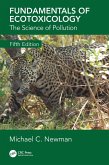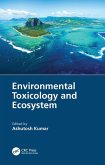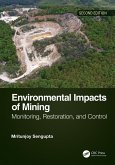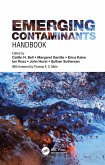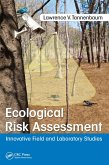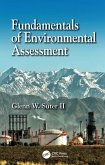Wayne Landis, Ruth Sofield, Ming-Ho Yu
Introduction to Environmental Toxicology (eBook, ePUB)
Molecular Substructures to Ecological Landscapes, Fifth Edition
117,95 €
117,95 €
inkl. MwSt.
Sofort per Download lieferbar

59 °P sammeln
117,95 €
Als Download kaufen

117,95 €
inkl. MwSt.
Sofort per Download lieferbar

59 °P sammeln
Jetzt verschenken
Alle Infos zum eBook verschenken
117,95 €
inkl. MwSt.
Sofort per Download lieferbar
Alle Infos zum eBook verschenken

59 °P sammeln
Wayne Landis, Ruth Sofield, Ming-Ho Yu
Introduction to Environmental Toxicology (eBook, ePUB)
Molecular Substructures to Ecological Landscapes, Fifth Edition
- Format: ePub
- Merkliste
- Auf die Merkliste
- Bewerten Bewerten
- Teilen
- Produkt teilen
- Produkterinnerung
- Produkterinnerung

Bitte loggen Sie sich zunächst in Ihr Kundenkonto ein oder registrieren Sie sich bei
bücher.de, um das eBook-Abo tolino select nutzen zu können.
Hier können Sie sich einloggen
Hier können Sie sich einloggen
Sie sind bereits eingeloggt. Klicken Sie auf 2. tolino select Abo, um fortzufahren.

Bitte loggen Sie sich zunächst in Ihr Kundenkonto ein oder registrieren Sie sich bei bücher.de, um das eBook-Abo tolino select nutzen zu können.
The fifth edition includes new sections on the use of adverse outcome pathways, how climate change changes how we think about toxicology, and a new chapter on contaminants of emerging concern. Additional information is provided on the derivation of exposure-response curves to describe toxicity and they are compared to the use of hypothesis testing.
- Geräte: eReader
- mit Kopierschutz
- eBook Hilfe
- Größe: 26.57MB
Andere Kunden interessierten sich auch für
![Fundamentals of Ecotoxicology (eBook, ePUB) Fundamentals of Ecotoxicology (eBook, ePUB)]() Michael C. NewmanFundamentals of Ecotoxicology (eBook, ePUB)112,95 €
Michael C. NewmanFundamentals of Ecotoxicology (eBook, ePUB)112,95 €![Environmental Toxicology and Ecosystem (eBook, ePUB) Environmental Toxicology and Ecosystem (eBook, ePUB)]() Environmental Toxicology and Ecosystem (eBook, ePUB)50,95 €
Environmental Toxicology and Ecosystem (eBook, ePUB)50,95 €![Engineering Tools for Environmental Risk Management (eBook, ePUB) Engineering Tools for Environmental Risk Management (eBook, ePUB)]() Engineering Tools for Environmental Risk Management (eBook, ePUB)48,95 €
Engineering Tools for Environmental Risk Management (eBook, ePUB)48,95 €![Environmental Impacts of Mining (eBook, ePUB) Environmental Impacts of Mining (eBook, ePUB)]() Mritunjoy SenguptaEnvironmental Impacts of Mining (eBook, ePUB)46,95 €
Mritunjoy SenguptaEnvironmental Impacts of Mining (eBook, ePUB)46,95 €![Emerging Contaminants Handbook (eBook, ePUB) Emerging Contaminants Handbook (eBook, ePUB)]() Emerging Contaminants Handbook (eBook, ePUB)177,95 €
Emerging Contaminants Handbook (eBook, ePUB)177,95 €![Ecological Risk Assessment (eBook, ePUB) Ecological Risk Assessment (eBook, ePUB)]() Lawrence V. TannenbaumEcological Risk Assessment (eBook, ePUB)106,95 €
Lawrence V. TannenbaumEcological Risk Assessment (eBook, ePUB)106,95 €![Fundamentals of Environmental Assessment (eBook, ePUB) Fundamentals of Environmental Assessment (eBook, ePUB)]() Glenn W. Suter IIFundamentals of Environmental Assessment (eBook, ePUB)86,95 €
Glenn W. Suter IIFundamentals of Environmental Assessment (eBook, ePUB)86,95 €-
-
-
The fifth edition includes new sections on the use of adverse outcome pathways, how climate change changes how we think about toxicology, and a new chapter on contaminants of emerging concern. Additional information is provided on the derivation of exposure-response curves to describe toxicity and they are compared to the use of hypothesis testing.
Dieser Download kann aus rechtlichen Gründen nur mit Rechnungsadresse in A, B, BG, CY, CZ, D, DK, EW, E, FIN, F, GR, HR, H, IRL, I, LT, L, LR, M, NL, PL, P, R, S, SLO, SK ausgeliefert werden.
Produktdetails
- Produktdetails
- Verlag: Taylor & Francis
- Seitenzahl: 490
- Erscheinungstermin: 29. September 2017
- Englisch
- ISBN-13: 9781498750462
- Artikelnr.: 55277020
- Verlag: Taylor & Francis
- Seitenzahl: 490
- Erscheinungstermin: 29. September 2017
- Englisch
- ISBN-13: 9781498750462
- Artikelnr.: 55277020
Since 1989, Wayne Landis has been the Director of the Institute of Environmental Toxicology and Chemistry, part of Huxley College of the Environment at Western Washington University. He is a graduate of Wake Forest University with a BA in Biology in 1974. He received an MA and a Ph.D. in Zoology from Indiana University in 1978 and 1979, respectively. He has authored over 120 publications and 300 scientific presentations. Dr. Landis has served on numerous committees and consulted for industry; NGOs; print and electronic media; and federal (U.S. and Canada), state, provincial, and local governments. In 2007 he was selected as a Fellow of the Society for Risk Analysis.
Dr. Landis has had a varied research program. During the 1980s and early 1990s he discovered and characterized enzymes that degrade organophosphates, and bacteria that metabolize riot control materials. He also conducted an extensive research program using microcosms to investigate the effects of jet fuels and other materials on the dynamics of ecological structures. Using patch dynamics models he also formulated the theory of how to incorporate landscape scale effects as part of environmental toxicology. He is the co-developer of the Community Conditioning Hypothesis, and the Action at a Distance Hypothesis. Currently his efforts have been to apply ecological risk assessment at regional and landscape scales using the relative risk model. The use of the relative risk model has now been applied to contaminated sites, invasive species, forestry and species conservations. The model has been used to estimate risk to sites across the world.
He has been the lead or co-editor on five books on environmental toxicology and risk assessment. He is currently serving on the Board of Editors for Human and Ecological Risk Assessment and is one of the Founding Editors for the new SETAC journal Integrated Environmental Assessment and Management and is the Environmental Risk Assessment Editor for Risk Analysis. Dr. Landis has served on the Board of Scientific Councilors for EPA and Ecological Process and Effects Committee of the SAB for the US Environmental Protection Agency.
Ruth M. Sofiled, Ph.D., is a Professor at the Huxley College of the Environment at Western Washington University. She has been at the university since 2003, and is one of the faculty specializing in environmental toxicology and chemistry. She routinely teaches environmental toxicology, and fate and transport courses at the university, as well as workshops in aquatic toxicology throughout the United States.
Dr. Sofield has a BA in biology from West Virginia University (1993), an MS in environmental science from McNeese State University (Louisiana) (1995), and an MS and Ph.D in environmental science and engineering from the Colorado School of Mines (1999, 2002). She completed her Ph.D. work in collaboration with the Center for Coastal Environmental Health and Biomolecular Research, Marine Ecotoxicology Branch, National Ocean Service, National Oceanic and Atmospheric Administration (NOAA), Charleston, South Carolina. This work focused on the genetically based tolerance to chemical exposures on Palaemonetes pugio. In 2003, Dr. Sofield completed her postdoctoral work on the binding of environmental ligands to uranium and plutonium.
Her current research program is focused on the effects of altered water chemistry and other environmental parameters on metal fate, transport, and aquatic toxicity. These studies range from laboratory bench scale to field scale investigations and include organism exposures combined with chemical modelling.
Dr. Landis has had a varied research program. During the 1980s and early 1990s he discovered and characterized enzymes that degrade organophosphates, and bacteria that metabolize riot control materials. He also conducted an extensive research program using microcosms to investigate the effects of jet fuels and other materials on the dynamics of ecological structures. Using patch dynamics models he also formulated the theory of how to incorporate landscape scale effects as part of environmental toxicology. He is the co-developer of the Community Conditioning Hypothesis, and the Action at a Distance Hypothesis. Currently his efforts have been to apply ecological risk assessment at regional and landscape scales using the relative risk model. The use of the relative risk model has now been applied to contaminated sites, invasive species, forestry and species conservations. The model has been used to estimate risk to sites across the world.
He has been the lead or co-editor on five books on environmental toxicology and risk assessment. He is currently serving on the Board of Editors for Human and Ecological Risk Assessment and is one of the Founding Editors for the new SETAC journal Integrated Environmental Assessment and Management and is the Environmental Risk Assessment Editor for Risk Analysis. Dr. Landis has served on the Board of Scientific Councilors for EPA and Ecological Process and Effects Committee of the SAB for the US Environmental Protection Agency.
Ruth M. Sofiled, Ph.D., is a Professor at the Huxley College of the Environment at Western Washington University. She has been at the university since 2003, and is one of the faculty specializing in environmental toxicology and chemistry. She routinely teaches environmental toxicology, and fate and transport courses at the university, as well as workshops in aquatic toxicology throughout the United States.
Dr. Sofield has a BA in biology from West Virginia University (1993), an MS in environmental science from McNeese State University (Louisiana) (1995), and an MS and Ph.D in environmental science and engineering from the Colorado School of Mines (1999, 2002). She completed her Ph.D. work in collaboration with the Center for Coastal Environmental Health and Biomolecular Research, Marine Ecotoxicology Branch, National Ocean Service, National Oceanic and Atmospheric Administration (NOAA), Charleston, South Carolina. This work focused on the genetically based tolerance to chemical exposures on Palaemonetes pugio. In 2003, Dr. Sofield completed her postdoctoral work on the binding of environmental ligands to uranium and plutonium.
Her current research program is focused on the effects of altered water chemistry and other environmental parameters on metal fate, transport, and aquatic toxicity. These studies range from laboratory bench scale to field scale investigations and include organism exposures combined with chemical modelling.

